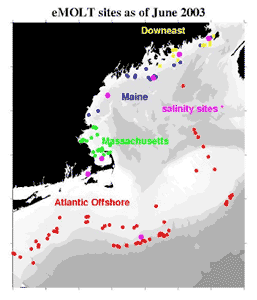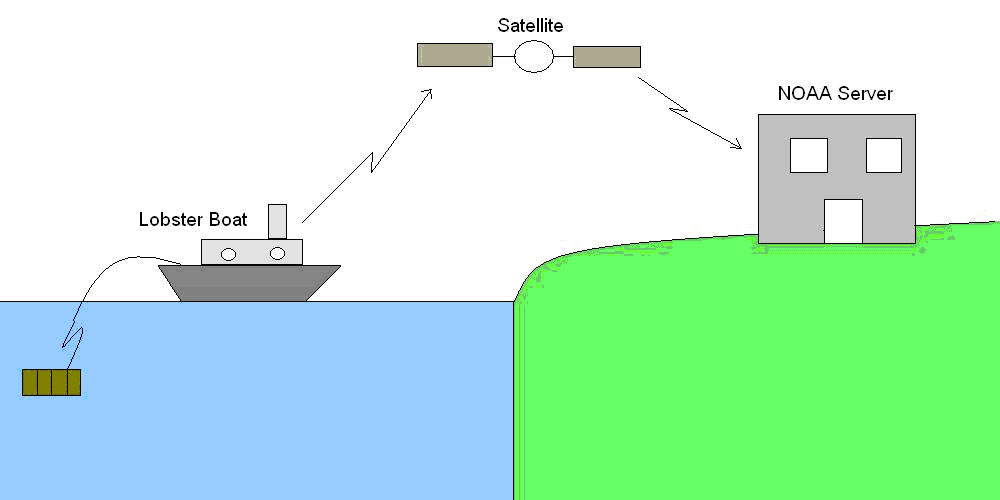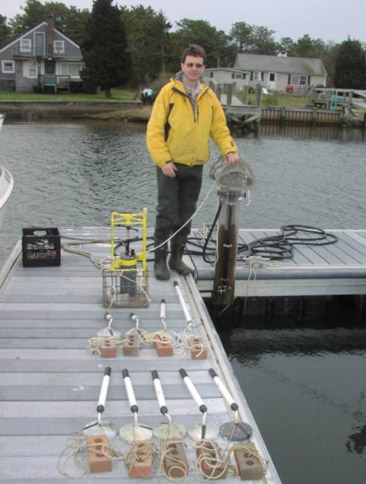eMOLT I: Temperature Probes
Since 2000, the Gulf of Maine Lobster Foundation (GOMLF) has worked with Jim Manning, oceanographer with NOAA Fisheries’ Northeast Fisheries Science Center, and several lobster industry associations to monitor the ocean’s bottom temperature throughout the Gulf of Maine. Volunteer lobstermen attach a temperature probe to their lobster traps and keep the trap at a fixed location throughout the year. Each time the trap is hauled, lobstermen record the date, time and location of the trap. The temperature probes are programmed to record the temperature every hour. Over 100 probes are deployed by 60 lobstermen from Maine, New Hampshire and Massachusetts. The two-fold objective of the temperature study is better understand the: 1. frequency and degree of thermal regime shifts in the Gulf of Maine region, and 2. effect these shifts may have on the migratory lobster populations in that area. Data is analyzed at the Northeast Fisheries Science Center and is available at www.emolt.org and through the Gulf of Maine Ocean Observing System (GOMOOS) This program is funded by the Northeast Consortium.

eMOLT II: Salinity Probes
From 2001 to 2003, six lobstermen around the Gulf of Maine deployed a salinity probe in one of their lobster traps. As with the temperature probe study, the trap was located at a fixed site throughout the year in order to track salinity events at that location. In addition to recording the date, time, location, and depth each time the trap was hauled, lobstermen were also required to take water samples from the bottom and maintain this sensitive equipment. Data from this study can be viewed at www.emolt.org. This program is funded by the Northeast Consortium.
eMOLT III: Database Management
This was a brief unsuccessful phase where we attempted to provide fishermen with “Thistle Deck Boxes” to record their catch but the company folded shortly after they supplied us with hardware.
eMOLT IV: Drifters
Lobstermen deploy satellite-tracked and non-satellite-tracked drifters at four sites in the Gulf of Maine: Cutler, Isle au Haut, Small Point, and Gloucester. At the beginning of each month from June to September 2004, lobstermen release four drifters at various depth transects. The objective of this study is to help document the degree of advection and dispersion into and away from various coastal zones in order to validate numerical ocean circulation models and better understand lobster larval transport in the Gulf of Maine. The drifters can also be tracked through reports called in by mariners who encounter them while at sea. Mariners should call 1-508-566-4080 and report the drifter ID and location of the sighting. The satellite drifters record location information every hour. To view the drifter tracks, visit www.emolt.org. Notice to Mariner poster.
eMOLT V: Real-time Temperature
Since the eMOLT began in 2001, many of the participants have asked, “How can we get a real-time temperature?” Given the recent advances toward a nation-wide ocean observing system, the idea is ripe. New England lobstermen now have an opportunity to make a significant contribution to the integrated system on the Northeast Continental Shelf by securing an unprecedented array of relatively inexpensive sensors on the seafloor. While the data will not be transmitted hourly (as many of the GOMOOS moorings are), it will be transmitted on a near-weekly basis (as often as lobstermen haul).
The biggest expense in conducting physical oceanographic research has traditionally been in ship time and the care of fixed moorings. These costs are essentially eliminated with the eMOLT system. There are a number of initiatives currently underway to coordinate oceanographic observations including the Gulf of Maine Ocean Data Partnership. Our objective is to become an active participant in these initiatives by sharing our data in real-time mode. While we would start by simply posting the bottom temperature, we would then propose in subsequent years to a) secure other sensors such as salinity, oxygen, pH, etc., and b) extend the instrumentation throughout the water column. If we can prove ourselves as potential contributors to the regional observing system, we hope to obtain sustained funding in the future. As of late 2022, the real-time system has become a reality with 20 thousand hauls having reported bottom temperatures.

eMOLT VI: Bottom Currents
Given the recent issue associated with potential whale entanglements in lobster gear and the uncertainty of whether sinking groundline is actually needed in some regions, we proposed in 2007 to develop a low-cost method of monitoring the bottom currents from lobster gear. As many lobstermen have suggested, the existing groundlines often lay down on the seafloor given strong currents in certain areas. While some work is currently underway to examine the degree to which groundline is dragged down, little is known about the spatial and temporal variability of bottom currents in these areas.
Since conventional means of monitoring bottom currents with commercially available instrumentation is cost prohibitive, we proposed to design and evaluate a simple concept of inferring bottom currents using locally-made $69 ONSET 3-d-accelerometers tethered above the ocean bottom. The method has been tested and validated with traditional current meters and has worked exceedingly well.
Beginning in the early summer of 2008, initial deployments were made within the Woods Hole Oceanographic Institute’s instrument test-well where significant tidal currents provide sufficiently-detectable observations. Deployments of more traditional instrumentation were also be made (alongside for comparisons) including two current meters: the Sontek Aquadopp owned by URI and the Nortek Vector owned by NEFSC.
After these initial multi-day deployments in Woods Hole, we propose to transfer the equipment to local lobstermen working in Cape Cod Bay. These individuals have tested eMOLT equipment for us in the past. This deployment will be conducted over multiple weeks in an attempt to detect variations due to storms and lunar periods.

Given the recent advances towards a nation-wide ocean observing system, the idea is ripe. New England lobstermen now have an opportunity to make a significant contribution to the integrated system on the Northeast Continental Shelf by securing an unprecedented array of relatively inexpensive sensors on the seafloor. In the past few years, there has been some effort in developing ocean observing systems in the region.
Both the National Science Foundation’s ORION project and NOAA’s IOOS project have funded several organizational meetings of potential partners but very little has resulted in the form of concrete governing structure. While all involved seem optimistic and hope for a large-scale coordinated system, a significant sum of money is needed to build such a network. So, until that money is available, we are forced to take small steps with low-cost alternatives.
These small steps will, at least, provide some form of background data in the intervening years and provide a system to gradually build in the future. Much of our previous eMOLT work involved developing a network of participants. While this outreach work (building relationships with fishermen) will certainly continue, we hope to now focus the majority of our effort in providing useful products in the form of web-served information.
